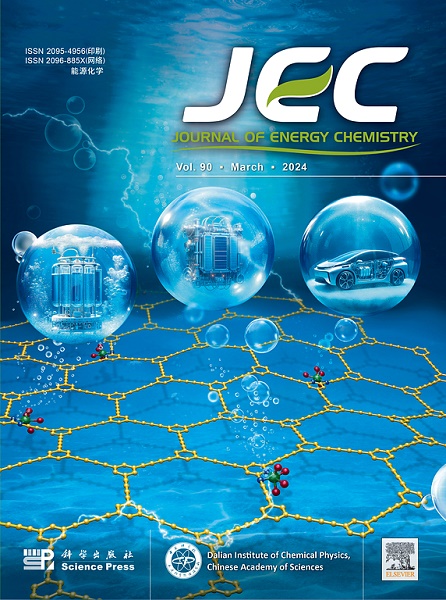二硫化钼在Co/C十二面体增强相变材料上的原位垂直排列
IF 13.1
1区 化学
Q1 Energy
引用次数: 0
摘要
太阳能热电发电机(STEG)能够利用太阳能转化为清洁电力,对于实现碳中和至关重要。由于相变材料(PCM)具有强大的热管理能力,因此无论太阳辐射通量如何,将相变材料(PCM)与 STEG 集成在一起都能促进发电。然而,PCM 固有的太阳-热转换效率限制阻碍了高持续电力输出的产生。本文提出了一种多维工程策略,将二维二硫化钼(MoS2)纳米片垂直原位排列在由零维(0D)钴纳米颗粒和三维(3D)高石墨化碳(源自 ZIF-67)组成的十二面体上,从而显著提高了聚乙二醇(PEG)的太阳能热电发电量。得益于多种成分的协同作用和独特的结构排列,所制备的 PEG-Co/C@MoS2 复合 PCM 的光热转换效率高达 92.89%。这种功能强大的 STEG 与热电设备结合后,可在 100 mW cm-2 的条件下产生 197.51 mV 的高持久输出电压和 52.47 mA 的电流,优于之前报道的大多数文献。这种集成了 PCM 的太阳能热电发电机克服了与时间和气象变化相关的限制,可同时进行高密度的供热和发电,从而实现节能和环境的可持续发展。本文章由计算机程序翻译,如有差异,请以英文原文为准。

In situ vertical alignment of MoS2 on Co/C dodecahedron boosting phase change materials for solar-thermoelectric generation
Solar-thermoelectric generators (STEGs) capable of harnessing solar energy for conversion into clean electricity are pivotal for advancing towards carbon neutrality. The integration of phase change materials (PCMs) with STEGs facilitates power generation regardless of solar radiation flux due to their robust thermal management capacity. However, the inherent solar-thermal conversion efficiency limitation of PCMs hinders the production of high and sustained electrical output. Herein, a multidimensional engineering strategy is proposed to align two-dimensional (2D) molybdenum disulfide (MoS2) nanosheets vertically in situ on a dodecahedron composed of zero-dimensional (0D) Co nanoparticles and three-dimensional (3D) high graphitized carbon derived from ZIF-67, thus significantly boosting the solar-thermoelectric energy generation of polyethylene glycol (PEG). The resultant PEG-Co/C@MoS2 composite PCMs exhibit a high solar-thermal conversion efficiency of 92.89%, benefiting from the synergy of multiple components and unique structural arrangements. When coupled with thermoelectric devices, this powerful STEG yields a high and durable output voltage of 197.51 mV and a current of 52.47 mA under 100 mW cm−2, outperforming the majority of previously reported literature. This PCM-integrated solar-thermoelectric generator overcomes limitations associated with temporal and meteorological variations, enabling simultaneous high-density heat and electricity generation for energy conservation and environmental sustainability.
求助全文
通过发布文献求助,成功后即可免费获取论文全文。
去求助
来源期刊

Journal of Energy Chemistry
CHEMISTRY, APPLIED-CHEMISTRY, PHYSICAL
CiteScore
19.10
自引率
8.40%
发文量
3631
审稿时长
15 days
期刊介绍:
The Journal of Energy Chemistry, the official publication of Science Press and the Dalian Institute of Chemical Physics, Chinese Academy of Sciences, serves as a platform for reporting creative research and innovative applications in energy chemistry. It mainly reports on creative researches and innovative applications of chemical conversions of fossil energy, carbon dioxide, electrochemical energy and hydrogen energy, as well as the conversions of biomass and solar energy related with chemical issues to promote academic exchanges in the field of energy chemistry and to accelerate the exploration, research and development of energy science and technologies.
This journal focuses on original research papers covering various topics within energy chemistry worldwide, including:
Optimized utilization of fossil energy
Hydrogen energy
Conversion and storage of electrochemical energy
Capture, storage, and chemical conversion of carbon dioxide
Materials and nanotechnologies for energy conversion and storage
Chemistry in biomass conversion
Chemistry in the utilization of solar energy
 求助内容:
求助内容: 应助结果提醒方式:
应助结果提醒方式:


